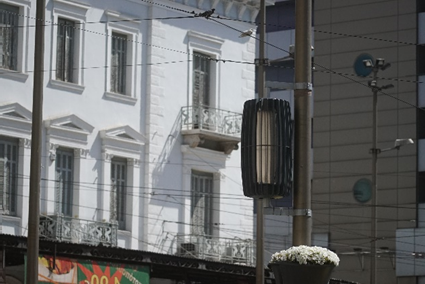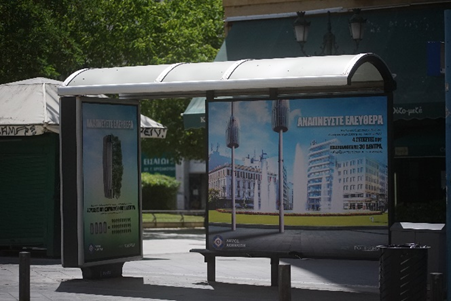Fine dust is a serious threat to public health, but with the right technologies and policies, its impact can be significantly reduced. Smart cities play a crucial role in this by utilizing innovative air purification solutions (such as the StaticAir PAMARES) and continuous data analysis. Through cooperation between governments, businesses, and citizens, we can work towards a future with clean and healthy air for everyone.
What is Fine Dust?
Fine dust, also known as PM (Particulate Matter), is a term used for tiny particles suspended in the air. These particles can be of natural origin, such as sand and sea salt, but can also be produced by human activities, such as vehicle emissions, industrial processes, and smoke from wood stoves. Fine dust is classified based on the size of the particles:
- PM10: Particles with a diameter smaller than 10 micrometers.
- PM2.5: Particles with a diameter smaller than 2.5 micrometers.
- Ultrafine dust: Particles smaller than 0.1 micrometer.
Health Impact of Fine Dust
The health risks of fine dust are significant. These small particles can penetrate deep into the lungs and even enter the bloodstream, leading to various health problems, such as:
- Respiratory diseases like asthma and bronchitis.
- Cardiovascular diseases.
- Increased risk of lung cancer.
- Aggravation of existing conditions like COPD.

The Role of Fine Dust in Smart Cities
Despite the advanced technologies and infrastructure that characterize smart cities, fine dust remains a problem for several reasons. Below are the main reasons:
- High Traffic and Industrial Activity
Smart cities are often economic hubs with heavy traffic flows and industrial activity, leading to high emissions of fine dust from vehicles and factories. Although smart cities strive for more sustainable transport solutions and industrial processes, reducing fine dust emissions remains a challenge due to existing infrastructure and economic interests. - Densely Built Environments
In densely built urban areas, fine dust can accumulate more easily and spread less effectively. Buildings can act as barriers that hinder air circulation, leading to higher concentrations of fine dust at street level. This effect is amplified in cities with tall buildings and narrow streets, which is known as the "urban canyon" effect. - Climate Change and Cities
Smart cities often experience the urban heat island effect, where urban areas are warmer than their rural surroundings. These higher temperatures can increase the concentrations of air pollution, including fine dust. Additionally, climate change can lead to more frequent and intense heatwaves and air pollution, further exacerbating the challenges posed by fine dust. - Challenges in Monitoring and Enforcement
Although smart cities benefit from advanced sensors and data analysis for monitoring air quality, enforcing regulations and implementing effective measures remains complex. This is due to the varying sources of fine dust, seasonal changes, and the need to balance economic growth with environmental and health goals. - Fluctuations in Fine Dust Levels
Smart cities monitor fine dust levels using sensor networks and data analysis to respond quickly to seasonal fluctuations, such as increased concentrations in winter due to wood burning/heating. Measures are implemented, such as promoting cleaner heating technologies, restricting traffic, and improving air purification systems to improve air quality.
Mobility and Transport
The transition to cleaner modes of transport, such as electric cars and public transit, is often gradual. In the meantime, traditional traffic remains a significant source of fine dust. Even in smart cities, where sustainable mobility is promoted, it may take time to fully adjust infrastructure and citizen behaviour.
Construction Activities
Smart cities are constantly evolving, with much construction activity for new infrastructure and buildings. These construction projects can generate significant amounts of fine dust, temporarily degrading air quality, despite measures such as water spraying and the use of dust barriers.
Monitoring, Data Analysis, and Air Purification: The Solution to Make Cities Healthy Again
With the presence of sensors in smart cities, air quality can be continuously monitored. StaticAir offers an air purification system that can be connected to these sensors, ensuring healthy air at all times. The advantage of continuous data analysis is that it is energy-efficient because, on days with high pollution, the system works at a higher frequency, or it doesn't need to work as hard when the air is cleaner.
From Smart City to Healthy City…
Fine dust remains a problem in smart cities due to the combination of health risks, high traffic and industrial activity, densely built environments, climate change, challenges in monitoring and enforcement, mobility and transport, and ongoing construction activities. Although smart cities can improve air quality with the StaticAir PAMARES, continuous effort and innovation are necessary to effectively address the impact of fine dust and ensure a healthy living environment for citizens.
Additional Benefits of the PAMARES Technology
The use of PAMARES technology contributes to the well-being and attractiveness of cities in several ways:
- Long-term healthcare cost savings: By reducing harmful fine dust particles in the air, PAMARES helps lower the exposure of residents to pollution. This results in fewer respiratory and cardiovascular issues, ultimately lowering healthcare costs and promoting a healthier population.
- Reduced damage to infrastructure: Fine dust and pollutants can damage buildings, bridges, and other urban infrastructure, for example, through corrosion. By reducing air pollution, PAMARES helps protect infrastructure, resulting in lower maintenance and replacement costs.
- A clean city is an attractive city: Clean air and a fresh environment improve the liveability of a city, attracting both residents and tourists. This increases the city's attractiveness, stimulates the local economy, and contributes to a positive urban reputation.
The Role of City Residents in This Collaboration
City residents play an important role in improving air quality through conscious choices and active involvement. Technologies like the StaticAir PAMARES are essential, but residents directly contribute to a cleaner city by making sustainable choices, such as cycling or using public transport more often and burning less wood.
By voicing their support for local clean air initiatives and participating in data-driven projects, citizens help effectively support policy and encourage the use of innovative solutions to combat air pollution. Together with governments and businesses, they are building a healthy and liveable city, where clean air and a sustainable future come first.
Technical Operation of the StaticAir PAMARES
The PAMARES from StaticAir was developed in the Netherlands as a sustainable solution to reduce air pollution in Smart Cities. This clean-tech innovation removes harmful fine dust particles from the outside air, significantly improving air quality. With PAMARES, cities can effectively achieve their emission targets, such as those outlined in the Climate Agreement of 2030. The system reduces large amounts of (ultra) fine dust and features LED indicators for real-time air quality display.
PAMARES is IoT-ready, making it ideal for data-driven urban management projects. Completely silent and without mechanical ventilation or filters, it offers a safe and sustainable solution. This makes PAMARES suitable for urban environments. Additionally, the system is scalable and requires little maintenance. PAMARES is a future-oriented choice for cleaner air in cities.

The Difference Between PAMARES and Other Air Purification Systems
The PAMARES from StaticAir stands out from other air purification systems due to its unique, sustainable design without filters or fans, making it specifically suitable for urban environments. The system uses electrostatic technology to remove fine dust, including ultrafine particles, from the air without generating noise or using energy-intensive components. As a result, PAMARES is completely silent, energy-efficient, and low-maintenance, leading to low operational costs. Since there is no need for filter replacement, the system also reduces waste and contributes to environmental friendliness.
PAMARES is ideal for Smart Cities and can be connected to IoT systems for real-time monitoring of air quality. With integrated LED indicators, both city managers and residents can immediately see the air quality. The system is robust, easy to scale, and requires little maintenance, making it a future-proof solution for cities striving for emission-free policies and clean, healthy air for their inhabitants.
From Smart City to Healthy City…
Fine dust remains a problem in smart cities due to the combination of health risks, high traffic and industrial activity, densely built environments, climate change, challenges in monitoring and enforcement, mobility and transport, and ongoing construction activities. Although smart cities can improve air quality with the StaticAir PAMARES, continuous effort and innovation are necessary to effectively address the impact of fine dust and ensure a healthy living environment for citizens.
Additional Benefits of the PAMARES Technology
The use of PAMARES technology contributes to the well-being and attractiveness of cities in several ways:
- Long-term healthcare cost savings: By reducing harmful fine dust particles in the air, PAMARES helps lower the exposure of residents to pollution. This results in fewer respiratory and cardiovascular issues, ultimately lowering healthcare costs and promoting a healthier population.
- Reduced damage to infrastructure: Fine dust and pollutants can damage buildings, bridges, and other urban infrastructure, for example, through corrosion. By reducing air pollution, PAMARES helps protect infrastructure, resulting in lower maintenance and replacement costs.
- A clean city is an attractive city: Clean air and a fresh environment improve the liveability of a city, attracting both residents and tourists. This increases the city's attractiveness, stimulates the local economy, and contributes to a positive urban reputation.
The Role of City Residents in This Collaboration
City residents play an important role in improving air quality through conscious choices and active involvement. Technologies like the StaticAir PAMARES are essential, but residents directly contribute to a cleaner city by making sustainable choices, such as cycling or using public transport more often and burning less wood.
By voicing their support for local clean air initiatives and participating in data-driven projects, citizens help effectively support policy and encourage the use of innovative solutions to combat air pollution. Together with governments and businesses, they are building a healthy and liveable city, where clean air and a sustainable future come first.
Technical Operation of the StaticAir PAMARES
The PAMARES from StaticAir was developed in the Netherlands as a sustainable solution to reduce air pollution in Smart Cities. This clean-tech innovation removes harmful fine dust particles from the outside air, significantly improving air quality. With PAMARES, cities can effectively achieve their emission targets, such as those outlined in the Climate Agreement of 2030. The system reduces large amounts of (ultra) fine dust and features LED indicators for real-time air quality display.
PAMARES is IoT-ready, making it ideal for data-driven urban management projects. Completely silent and without mechanical ventilation or filters, it offers a safe and sustainable solution. This makes PAMARES suitable for urban environments. Additionally, the system is scalable and requires little maintenance. PAMARES is a future-oriented choice for cleaner air in cities.

The Difference Between PAMARES and Other Air Purification Systems
The PAMARES from StaticAir stands out from other air purification systems due to its unique, sustainable design without filters or fans, making it specifically suitable for urban environments. The system uses electrostatic technology to remove fine dust, including ultrafine particles, from the air without generating noise or using energy-intensive components. As a result, PAMARES is completely silent, energy-efficient, and low-maintenance, leading to low operational costs. Since there is no need for filter replacement, the system also reduces waste and contributes to environmental friendliness.
PAMARES is ideal for Smart Cities and can be connected to IoT systems for real-time monitoring of air quality. With integrated LED indicators, both city managers and residents can immediately see the air quality. The system is robust, easy to scale, and requires little maintenance, making it a future-proof solution for cities striving for emission-free policies and clean, healthy air for their inhabitants.


